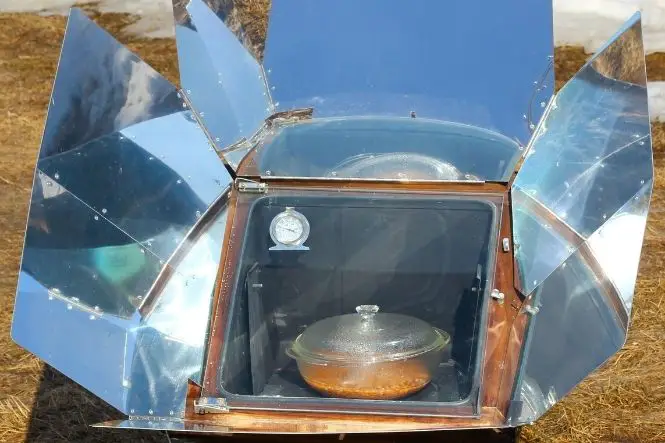Cooking with the sun (solar cooking) provides free, safe, clean heat energy that preserves nutrients in food.
Cooking with the Sun
On a clear, bright, sunny day, line a mixing bowl or colander with aluminium foil (shiny side up), and smooth it as much as possible, to make a solar reflector. Put the bowl in a sunny place, facing the sun. Feel around inside the bowl to find the hottest place, put a piece of modelling clay there and stick a toothpick in it. Put a marshmallow on the toothpick. Watch the marshmallow – what happens? Try it with a small potato or piece of potato – how long does it take to cook?
This is a simple solar cooker. Solar cookers are used in developing countries as safe, cheap and efficient ways to cook food, avoiding use of indoor wood stoves. According to the World Health Organisation, breathing in the smoke from a wood-fired stove is as bad as smoking two packets of cigarettes a day. Solar cooking also reduces the time that people need to spend looking for fuel, potentially in dangerous situations. Using less wood protects the environment, reducing deforestation and soil erosion (see ‘Seeing Soil Erosion’).
Food cooked in a solar cooker retains nutrients and flavours, and is unlikely to burn so can be left to cook all day without attention (and the pots are easier to clean). It keeps houses cooler, as there is less need for a fire.
The simplest solar cookers are based on boxes with clear glass or plastic lids and black or reflective insides. These can be used on partly overcast days and will get up to 50-150 degrees Centigrade. More complex solar cookers use reflectors, including parabolic reflectors (see next section). These can reach up to 350 degrees Centigrade but need direct sunlight, and may need to be moved to track the sun.
Solar cookers use shallow black-coated pots with tight-fitting lids to absorb the heat, and insulation to retain the heat (this may be as simple as putting the pot in a clear heat-resistant plastic bag, clipped shut). People can combine solar cooking with hay-box cooking, especially if the sun goes in (see ‘Keeping Warm or Cold: Insulation and Conduction’).
Solar cookers might take up to twice as long to cook food as conventional cookers. Solar cookers can cook all kinds of food, from bread and vegetables to meat, rice, beans, soups and casseroles. Solar cookers can also dry vegetables and fruit, preserving them for the winter.
People in the developing world can also use solar cookers to disinfect food, milk and water, killing germs and parasites, and to desalinate (take the salt out of) water.
Parabolic Reflector
A parabolic reflector is designed to collect energy, e.g. light, radio waves or sound, and focus it at one point. The foil-lined mixing bowl is a parabolic reflector for heat energy from sunlight. Parabolic reflectors in a solar furnace can create temperatures of over 3,000 degrees Centigrade, hot enough to melt steel, generate electricity or create hydrogen fuel.
Parabolic reflectors were first described in the 10th century. Other uses of parabolic reflectors include satellite dishes, reflecting telescopes, radio telescopes, parabolic microphones and reflectors in spotlights, car headlights and LEDs.






